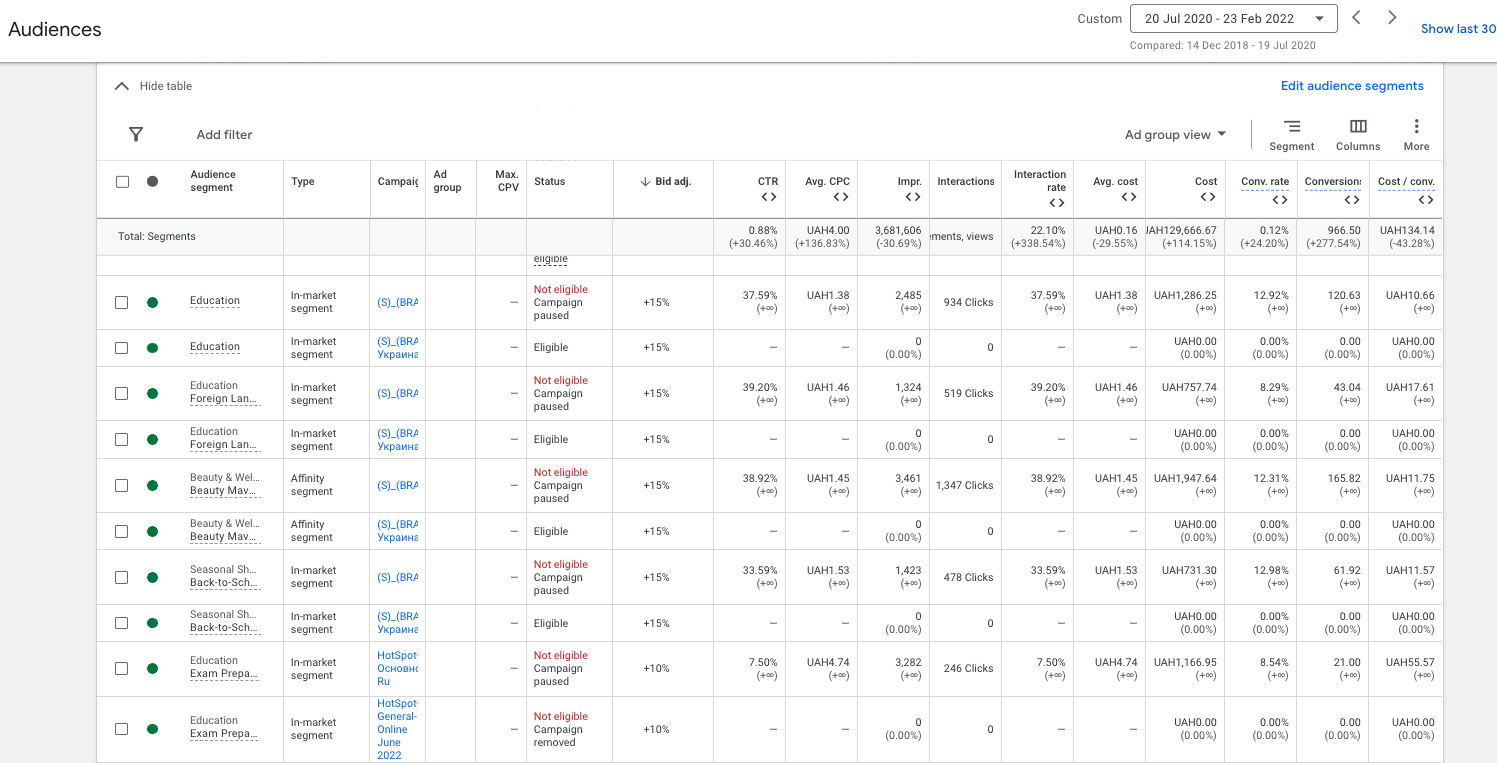case study
PPC advertising in Google
Ads for foreign languages school
HOTSPOT


Location
Ukraine

Start date
August 2015, July 2020

Category
Education

View
Website 
Task
- Bringing in new students at various language proficiency levels to the English-language school;
- Both the number of visits to and the average time spent on the HOTSPOT school website should rise;
Project features
- High price;
- Students approved by testing results;
- Hardcore classes;
- Any student can be expelled at any time without a refund;
Tools and services
Project description
School of Hardcore English HOTSPOT is an English language school from which you will be counted and where you will learn English.

Solution
Contextual advertising in Google Ads for Foreign Languages School
A great way to attract new clients and test your concepts is through contextual advertising.
Google Analytics was fully set up to track user activity on the HOTSPOT school website and registrations. Hotjar was linked in order to gain a better understanding of audience behavior on the website.
Facebook Ads received the majority of the advertising attention. In order to draw visitors to the website, familiarize them with details about the school, and encourage them to pass the online test, advertising campaigns were developed.
The school’s website also has a prepared and implemented online form for passing the test.
Updated 2022 yr.
The school came back to our agency in 2020 following the initial advertising event in 2015–2016. The goal was to draw students to the school for both online and classroom instruction. We created a work plan after examining the settings and accounts, according to which we first addressed the errors made by earlier freelancers and agencies before methodically moving toward the desired outcomes.
The work schedule for using Google Ads:
– checking the completion of goals on the site
– work with the semantic core, constant tracking of search requests
– regrouping the keywords
– launch new campaigns
– testing a new strategy
– work with remarketing audiences and competitors targeting
– testing different lines in ads
– replacement of announcement with course dates
– replacement of banners
– exclusion of inefficient placements for Display Network
– adjustment of rates
– constant account optimization
Google Ads account optimization for foreign languages school
The client had a functioning Google Ads account from the beginning, was connected to Analytics and Google Tag Manager, and had conversions set up (tracking of forms for sending applications and passing the test, Binotel Call Tracking, clicks by phone numbers, time on the site of 2 minutes, JivoSite is currently replaced by another widget).
Our company always begins work with a thorough analysis of the website, specifically with a check on the establishment and proper execution of goals – this is one of the crucial steps for subsequent work. We examine account structure, geographic targeting, display strategies, keyword and phrase matching, search terms, ads, conversion rates, and average cost per conversion. The effectiveness of contextual advertising is determined by a number of additional indicators as well.
The conversion of “clicking on numbers” was halted at this point in the project because it wasn’t always clear whether the call had actually been placed or not. The call won’t be placed, especially if the click came from a desktop, but the conversion will still be recorded. Since we had other tasks to complete at this point in the project, the goal “time on the site 2 minutes” was also disabled.
Initial conversion information:

The results were then continuously scaled and optimized after corrections were made in light of the analysis.
expanded the semantic core, which now includes queries for brands, products, and information. We carefully practiced cross-minus and worked with negative words. As time went on, we kept adding new keys.
Some of the newly launched search campaigns are meant to draw new students to Kharkiv. The second was designed for online classes with Kyiv-based students. The launch of new remarketing and rival media campaigns. Banners were updated frequently, which was crucial for informing potential customers when new groups were starting.
We experimented with various ad formats, including dynamic, static, adaptive, graphic, and media. The longest extensions were used. In order to increase CTR, special attention was paid to the relevance of a search query appearing in the titles and descriptions of ads.
Before implementing broad keyword matching to transition to an intelligent bidding strategy, new advertising campaign strategies were tested once the account had accumulated enough statistics. For instance, you won’t be able to optimize if you only use exact match auto strategies.
In the future, this made it possible to concentrate on the plan that was best for boosting the project’s efficiency.
We were able to achieve targeted and interested traffic to the site, which was later converted into high-quality applications, by quickly creating new campaigns that were focused on the beginning of new courses, working out keywords for each proposal, and writing ads from UTP.
For each campaign, we changed the device bids separately in order to scale and optimize the results. In order to maximize the budget, the rates for conversion rates were raised, while they were lowered for non-conversion devices. Similarly, after adding the maximum number of “observation” audiences, we worked with them. Additionally, demographic information did not escape our attention; using this lever, we changed the audience’s age range that we found interesting.
An illustration of how Google Ads bid adjustments for audience segments:

Despite being “expensive” for us, some keywords had to be stopped after the analysis because they weren’t working. However, the work with requests did not stop there; if we had not carefully planned at the beginning, we would have had to constantly replenish and clean our list.
Excluded pricey platforms for KMS ad display, as well as completely excluding ad display in mobile apps. And this represents just a small portion of the optimization work.
Naturally, each project has its own unique nuances and challenges that experts must overcome, but we always find solutions. One of these participated for a while in a smart search campaign whose unstated goal is to generate conversions from branded queries. Given that the keyword topic does not include this query.
The campaign appears to be succeeding, which is good, but it was crucial for us to display advertising on “hot” competitive queries. Particularly given that the account already had a distinct brand campaign.
Adding minus words had no impact; the campaign persisted in converting searches that were “not interesting” to us. Contacting the Google Ads support service will allow you to complete this task; upon your request, a technical expert will “manually” exclude the brand word.
Contextual advertising appears straightforward on the surface, but in reality, it involves a lot of routine technical and analytical work.
The outcomes were: a 95.28% increase in conversions, a 4.42% decrease in average cost per conversion. However, given that we disabled ineffective goals at the beginning but these indicators are shown for the comparative period, we can infer that the increase in conversion indicators and the decline in its average price are significantly higher than shown in the graph.
Data on the effectiveness of Google Ads from July 20, 2020, to February 23, 2022:

Google Analytics data for the same period:

+120%
Number of students increase
+800
Educated students
+94%
Avg. time spend on website increase
Results
View other cases


ARE YOU READY TO IMPROVE YOUR PROJECT WITH #UAATEAM?
We will be happy to discuss your project, along with your main goals and objectives. You can schedule a meeting with one of our managers.










